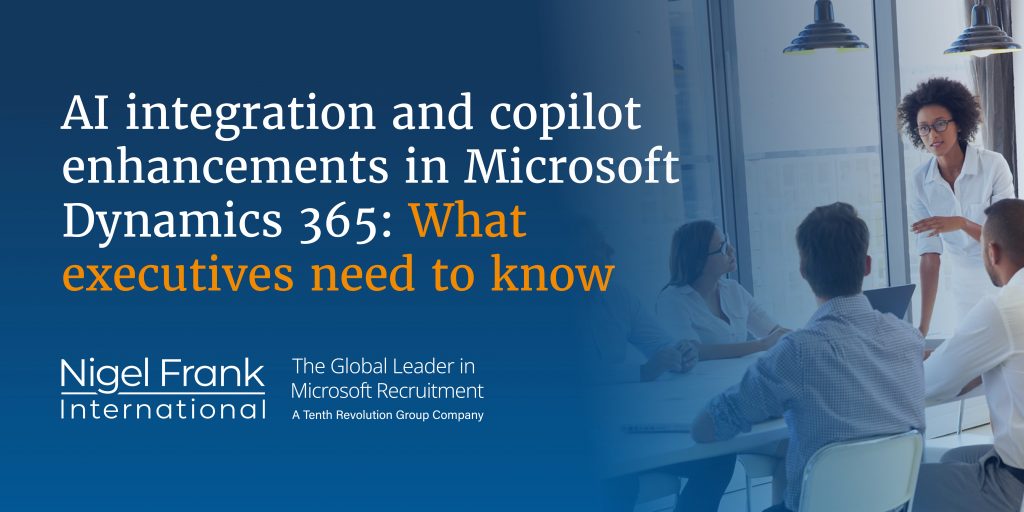
Microsoft is pushing Dynamics 365 beyond traditional ERP and CRM functionality, embedding AI and digital assistant features that promise to transform how businesses operate.
For business leaders, these advancements signal more than new features—they represent a shift in how enterprises can leverage technology to drive efficiency and insight.
Here’s what’s changing and how to approach it. Here’s what’s new and why it matters.
Copilot is becoming the backbone of Dynamics 365
Microsoft’s AI Copilot has evolved from an assistive tool to a central component of the Dynamics 365 ecosystem. Recent updates include:
Context-aware automation in sales
Copilot now drafts emails, suggests follow-ups, and even predicts deal risks by analyzing historical data and communication patterns. Copilot can provide a sales rep with an automated summary of a customer’s recent interactions before a call, for example, with talking points pulled from past emails and contracts.
AI-driven supply chain adjustments
Dynamics 365 Supply Chain Management now integrates real-time external data like weather and shipping delays to recommend inventory shifts. So if a storm disrupts a key shipping route, the system automatically reroutes orders and updates delivery estimates.
Frictionless customer service
Customer service agents get AI-generated response drafts, pulling from knowledge bases and previous cases to maintain consistency.
These features save time, reduce human error, and keep teams aligned.
Struggling to find Dynamics 365 experts who can help you unlock the full potential of Copilot? Nigel Frank specializes in connecting businesses with the talent they need to make these projects a success.
How new integrations are bridging data silos
Microsoft is aggressively connecting Dynamics 365 with other enterprise tools, reducing the need for manual data entry:
Outlook and Teams deep integration
Meeting notes in Teams automatically sync to relevant customer records in Dynamics 365, and sent emails in Outlook are logged against the correct account without manual tagging.
Power BI embedded analytics
Instead of static reports, users can now ask natural language questions like, “Show me Q2 sales trends for high-value clients in the Midwest,” while the system generates visualizations on the fly, updated with live data.
Azure OpenAI Service connectivity
Companies can now fine-tune AI models on their own data, like pricing, inventory, and customer histories, while keeping everything within Microsoft’s compliance boundaries. This interoperability turns Dynamics 365 into a central nervous system for business operations rather than just another software tool.
Industry-specific AI models are arriving
Generic AI has limits, which is why Microsoft is rolling out tailored solutions for key sectors.
- Retail solutions that use AI to optimize markdowns by predicting which products will stagnate, using local buying trends and competitor pricing.
- Manufacturing tools that predict equipment failure and factor in maintenance history, sensor data, and supplier lead times for parts.
- Financial services AI agents that create automated risk assessments that cross-reference market data, client portfolios, and compliance rules.
These aren’t hypothetical.Early adopters in manufacturing have reported 85% less unplanned downtime during pilot tests.
As Copilot becomes central to the Dynamics ecosystem, having the right skills in place will be critical. Nigel Frank can help you build the teams that keep your business ahead of the curve.
What this means for your business
So how will the rise of Copilot shape the future for Dynamics 365 users? For starters, productivity will shift, with employees spending less time on manual tasks like data entry and report generation and more on strategy.
You’ll know that skill requirements for your teams are already changing, and Copilot will hasten the need for training on prompt engineering and AI validation, not just software navigation.
And data quality matters more than ever. We all know that old phrase “garbage in, garbage out,” and that couldn’t be more relevant in an AI-powered world. AI outputs are only as good as the inputs, so things like inconsistent CRM entries or outdated inventory records will undermine results.
These are some big changes to navigate, but there are plenty of things you can do to get ahead in the Copilot era. Try experimenting with a single high-impact use case, like sales email automation or inventory forecasting, before expanding your Copilot strategy. Audit your data by cleaning customer records and transactional history now, before that shoddy data can impact AI results. And assign an AI workflow lead—someone who understands both the business processes and the tech capabilities—to lead on this transition to Copilot-powered processes.



